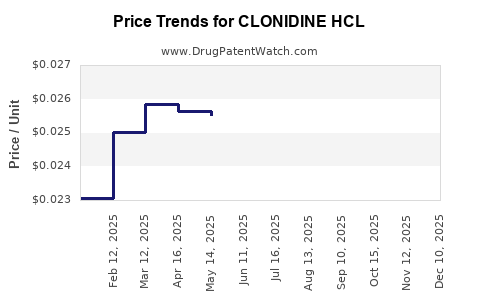Drug Price Trends for CLONIDINE HCL
✉ Email this page to a colleague

Average Pharmacy Cost for CLONIDINE HCL
| Drug Name | NDC | Price/Unit ($) | Unit | Date |
|---|---|---|---|---|
| CLONIDINE HCL 0.1 MG TABLET | 00904-7442-61 | 0.02022 | EACH | 2024-11-27 |
| CLONIDINE HCL 0.1 MG TABLET | 29300-0468-01 | 0.02022 | EACH | 2024-11-20 |
| CLONIDINE HCL 0.1 MG TABLET | 29300-0468-05 | 0.02022 | EACH | 2024-11-20 |
| CLONIDINE HCL 0.1 MG TABLET | 00228-2127-10 | 0.02022 | EACH | 2024-11-20 |
| CLONIDINE HCL 0.1 MG TABLET | 29300-0468-10 | 0.02022 | EACH | 2024-11-20 |
| CLONIDINE HCL 0.1 MG TABLET | 00228-2127-50 | 0.02022 | EACH | 2024-11-20 |
| >Drug Name | >NDC | >Price/Unit ($) | >Unit | >Date |
Best Wholesale Price for CLONIDINE HCL
| Drug Name | Vendor | NDC | Count | Price ($) | Price/Unit ($) | Unit | Dates | Price Type |
|---|---|---|---|---|---|---|---|---|
| DURACLON 100MCG/ML INJ | Mylan Institutional LLC | 67457-0218-10 | 10ML | 23.12 | 2.31200 | ML | 2024-01-01 - 2028-09-28 | FSS |
| DURACLON 100MCG/ML INJ | Mylan Institutional LLC | 67457-0218-10 | 10ML | 12.10 | 1.21000 | ML | 2023-09-29 - 2028-09-28 | Big4 |
| DURACLON 100MCG/ML INJ | Mylan Institutional LLC | 67457-0218-10 | 10ML | 12.10 | 1.21000 | ML | 2023-09-29 - 2028-09-28 | FSS |
| DURACLON 100MCG/ML INJ | Mylan Institutional LLC | 67457-0218-10 | 10ML | 23.12 | 2.31200 | ML | 2023-10-12 - 2028-09-28 | FSS |
| DURACLON 100MCG/ML INJ | Mylan Institutional LLC | 67457-0218-10 | 10ML | 13.14 | 1.31400 | ML | 2024-01-01 - 2028-09-28 | Big4 |
| CLONIDINE HCL 0.1MG TAB,SA | AvKare, LLC | 00228-4241-06 | 60 | 139.11 | 2.31850 | EACH | 2023-06-15 - 2028-06-14 | FSS |
| >Drug Name | >Vendor | >NDC | >Count | >Price ($) | >Price/Unit ($) | >Unit | >Dates | >Price Type |


